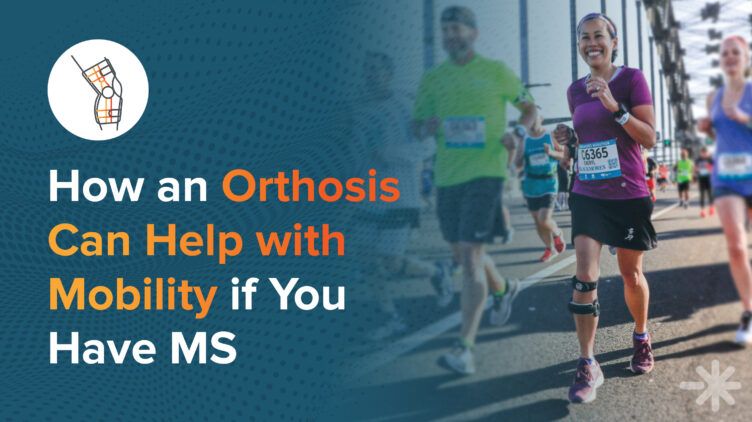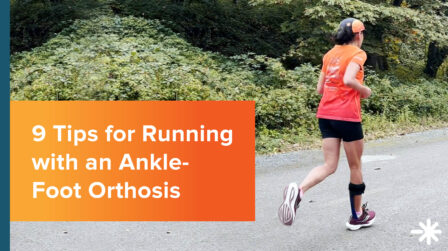How an Orthosis Can Help with Mobility if You Have Multiple Sclerosis (MS)

Difficulty walking due to muscle weakness, muscle spasms, and balance issues is one of the most common struggles among people who have multiple sclerosis (MS). Orthoses can help people with MS in a number of ways, including helping to improve mobility, eliminate gait deviations, and reduce the risk of falls.
What is MS?
Multiple sclerosis (MS) is an unpredictable disease of the central nervous system that disrupts the flow of information within the brain, and between the brain and body.1 In MS, the immune system mistakenly attacks the protective coating surrounding the nerve called myelin, leading to inflammation and scarring (sclerosis) in the central nervous system. This disrupts the proper functioning of the nerves, resulting in various neurological symptoms.
Signs and symptoms of MS vary widely and depend on the location and severity of nerve fiber damage in the central nervous system. While some people with MS experience an array of symptoms, others may experience long periods of remission without any new symptoms.2
MS and Walking Difficulties
During your appointment, your Hanger Clinic orthotist will assess your gait, symptoms, and discuss your personal goals. Common symptoms that may impact your mobility and ability to walk include:
- Fatigue. Weak muscles require more effort to perform tasks, leading to increased fatigue. Individuals with MS may find that your muscles tire more quickly, impacting your ability to engage in physical activities or perform daily tasks. Fatigue is one of the most common symptoms of MS, occurring in about 80 percent of people.3
- Spasticity. Spasticity refers to involuntary muscle contractions, feelings of stiffness or tightness within muscles, and a wide range of involuntary muscle spasms which can further impair movement and coordination.3
- Weakness. Muscle weakness in the legs can lead to difficulties with walking, balance, and coordination. This may result in a wobbly gait or an increased risk of falls. MS-related muscle weakness can also affect the upper limbs, making it challenging to perform tasks that require fine motor skills, such as writing, grasping objects, or manipulating small items. Weakness can also occur due to lack of use.3
- Numbness or Tingling. Numbness and tingling sensations often occur in the extremities, such as the arms, legs, hands, and feet, but they can also affect other parts of the body. These sensations may be described as a “pins and needles” sensation, a feeling of “electric shocks,” or a general loss of sensation. The specific location and severity of numbness and tingling can vary among individuals with MS. Some people may experience mild and temporary episodes, while others may have persistent and more pronounced symptoms. Additionally, the sensations may come and go or remain constant over time.3
Treatment Options
An orthosis, also known as an orthotic device or brace, is an effective treatment option for those living with MS and experiencing muscle weakness, balance issues, and gait or walking difficulties. Orthoses are external devices designed to support, stabilize, or correct various parts of the body. In the context of MS, orthoses can provide support to weakened muscles, improve balance, and enhance functional mobility. Common diagnoses for an orthosis include:
- Foot Drop. Foot drop, also known as drop foot, is when you have a difficult time raising the front part of your foot, preventing a natural heel-to-toe stepping motion. It can impact your speed, balance, endurance, and walking pattern. Typical forms of treatment may include an ankle-foot orthosis or functional electrical stimulation (FES) to control foot drop and help improve your gait pattern, reduce the risk of falls, and increase safety.
- Knee Instability. Another common problem in MS is knee instability, in which the knee either buckles and gives way, or hyperextends, extending outwardly behind the knee. This can also cause gait or balance issues. A knee orthosis or knee-ankle-foot orthosis can benefit those with more significant muscle weakness or instability in the lower limbs.
Goals
You will work with your orthotist to establish goals for your lifestyle and activity levels. Typical goals may include improving your ability to walk, controlling foot drop, preventing falls, and getting back to the activities you love in life. Your orthotist will work with you and your care team to establish the best treatment option and provide care and support. Advocate for yourself with your care team and explore your options as you feel your symptoms progress.
Request a Free Evaluation
If you or someone you love are looking for personalized, high-quality care, get in touch with a board-certified orthotist at a Hanger Clinic near you.
Latest Updates
Subscribe to stay up-to-date on our latest posts.



